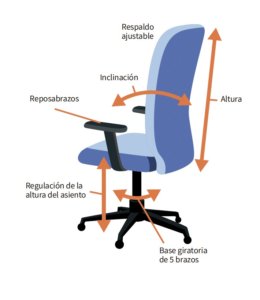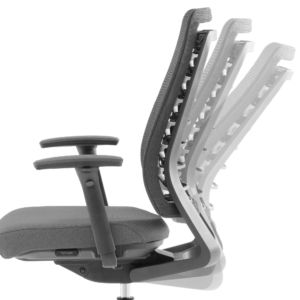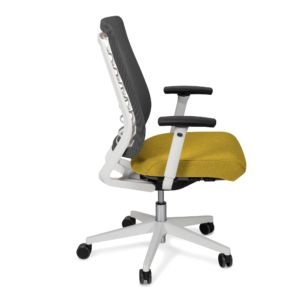How to adjust an ergonomic office chair to sit comfortably and prevent muscle problems. We offer you some guidelines in this article, but first let’s remember why adjusting the chair is so important.
30% of employees who work in offices complain of back pain, 17% of muscle pain in the arms and legs and 45% say they work in positions that are painful or cause fatigue. A bad office chair is in a very high percentage the cause of these ailments.
If it is not ergonomic, an office chair can be a source of problems for its users caused by the adoption of incorrect postures in the workplace, as well as excessive sedentary lifestyle. When you sit for a long time, the pressure on your back increases, and although at first you don’t feel discomfort, over the years serious problems and diseases can appear
But it is also very common that the office chair is ergonomically perfect, but that we do not adjust it correctly. The result: cervical pathology, dorsal affections, fatigue and lumbar injuries.
Some of these problems are minor pain, but in other cases they are more serious medical problems that require treatment and require sick leave, if not incapacity for work.
How to adjust an office chair to adopt the correct posture
Adjusting an office chair is very important to adopt the correct posture. But what is this position?
First of all, before addressing how to adjust an office chair, it is necessary to remember that we have to replace static postures with that of sitting in active movement. To do this, the back of the chair must not be excessively rigid. It has to allow some flexibility, moving at small angles about a fixed position.

Second, it is very important that you do not sit in the same position for a long time. Change posture frequently. And saying this:
The column must be upright, since in this way it presents its natural open S shape, and supported by the back of the chair.
- The posture should be as stable as possible; that is, that the user is not slumped in his seat.
- The legs slightly open and the two soles resting on the ground; without crossing your legs one above the other and maintain that posture.
- The knees should form a right angle with the muscles.
- The foot should form an angle of approximately 90º with the calf.
- The vertical calf, and forming an angle of 90º with the thigh.
- The thigh horizontal and forming an angle of 90º with the trunk.
How to adjust an ergonomic chair to the characteristics of each person
An ergonomic chair is one of the guarantees of a healthy workplace. It is recommended to adjust the ergonomic chair so that it can be adapted to the characteristics of each person and to those of the task to be performed, which we will achieve with an adjustable office chair.
These are the characteristics to take into account when selecting an ergonomic work chair, according to the “Ergonomics Guide for remote work”, prepared by AESPLA, the IBV and FAMO:
- It is recommended that the seat of the chair has a pivoting mechanism that allows the chair to rotate 360º, which will facilitate movement and access to the elements that are needed, avoiding twisting of the trunk and other inappropriate postures.
- The chair must have 5 legs with wheels, for reasons of stability and mobility.
- The inclination of the backrest must be adjustable.
- The seat surface should be as comfortable as possible, allowing full support for the buttocks and thighs. Also, you should avoid slipping. The seat must not generate compression at any point that could be an impediment to blood circulation. It must be possible to adjust the height of the seat while in a sitting position. And the feet should reach a support surface without feeling pressure on the back of the legs.
- It is recommended that the chair ensure adequate support for the lumbar region, through a mechanism for regulating pressure and adjusting the height of the lumbar support. This
 adjustment can be achieved with mechanisms for adjusting the height of the backrest, which allow movement of the entire backrest; or with lumbar support height adjustment mechanisms that allow the movement of the lumbar support device, keeping the backrest fixed.
adjustment can be achieved with mechanisms for adjusting the height of the backrest, which allow movement of the entire backrest; or with lumbar support height adjustment mechanisms that allow the movement of the lumbar support device, keeping the backrest fixed. - It is recommended that the chair has armrests, and that they are adjustable or easily removable so that they do not pose an impediment to approaching the work table. Its length should be somewhat less than that of the seat so that it does not prevent us from bringing the chair closer to the table. Also, they should be thick and should not have sharp edges.
Before adjusting your office chair, read the instructions
Therefore, the ergonomic office chair must be adjustable. It is essential to know the adjustments of the work chair and how to use them in order to adapt it to the characteristics of each person and the tasks to be carried out in a way that provides the maximum preventive benefit.
How to adjust an office chair? In the instructions for use that should always accompany office chairs, the regulations it has and how they are used are explained.
Let’s see an example of how to adjust an Ofita office chair, specifically, Hara:
-
Activate the right side handle that is closest to the knees to adjust the height of the seat.
-
Activate the right side handle that is closer to the backrest, to adjust the depth of the seat.
-
The chair has an automatic synchro system with multi-position locking and safety anti-return.
-
Activating the left side handle we lock the synchro position. To unlock, activate the handle again and press the backrest with your back. For a fine adjustment of the synchro tension, adjust the
 wing nut at the bottom.
wing nut at the bottom. -
Lumbar support adjustable in height in 8 positions. (Element to add as optional). Adjustable by pulling up/down the ends of the lumbar support.
-
Adjustable arms in width, height, depth and angle. The armrests are correctly adjusted when, resting your elbows on them, your forearms are parallel to the work surface. On the arm itself, we have the button for adjusting the height of the arms and a lower lever under the seat that, when unlocked, allows the width between the arms to be adjusted. To adjust the depth, simply slide the cover of the arm.
How to adjust the height of an office chair?
Once we are in a sitting position, with buttocks, thighs and back well supported, when approaching the table, it should be approximately at elbow height (vertical arms and horizontal forearms at right angles from the elbow and aligned with the keyboard).
If the table is too high, you will have to raise the height of the seat until it is at elbow height. To do this, activate the handle that in most models of ergonomic office chairs is on the right side near the knees.

Hara chair
If when adjusting the height of the office chair so that it is in coordination with the table, your feet do not reach the ground, we recommend that you use something to support your feet. The ideal is to have an ergonomic footrest:
- That it has adjustable inclination between 0° and 15° on the horizontal plane.
- That its minimum dimensions are 45 cm wide and 35 cm deep.
- That its surface is non-slip, both in the foot support area and in the base in contact with the ground.
All the adjustment systems that we have mentioned must be safe to handle and accessible from a seated position, without requiring too much effort to activate them. They must not be activated unintentionally.
To conclude, we can summarize the requirements of an ergonomic office chair in three: That it be adaptable to the needs and anthropometric characteristics of 90% of people, that it be comfortable, adapting to the curves of the body, and that it be safe.
And remember: do not use your chair as it is delivered to you. Sit in the chair and lean back until your lower back rests on the backrest. Adjust the seat height until your feet are flat on the ground. If you can’t, request a footrest. The table should be at elbow height or a little higher. Adjust the height of the armrests, the height of the backrest and its inclination.





